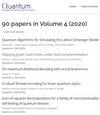Parallel Quantum Algorithm for Hamiltonian Simulation
IF 5.1
2区 物理与天体物理
Q1 PHYSICS, MULTIDISCIPLINARY
引用次数: 0
Abstract
We study how parallelism can speed up quantum simulation. A parallel quantum algorithm is proposed for simulating the dynamics of a large class of Hamiltonians with good sparse structures, called uniform-structured Hamiltonians, including various Hamiltonians of practical interest like local Hamiltonians and Pauli sums. Given the oracle access to the target sparse Hamiltonian, in both query and gate complexity, the running time of our parallel quantum simulation algorithm measured by the quantum circuit depth has a doubly (poly-)logarithmic dependence $\operatorname{polylog}\log(1/\epsilon)$ on the simulation precision $\epsilon$. This presents an $\textit{exponential improvement}$ over the dependence $\operatorname{polylog}(1/\epsilon)$ of previous optimal sparse Hamiltonian simulation algorithm without parallelism. To obtain this result, we introduce a novel notion of parallel quantum walk, based on Childs' quantum walk. The target evolution unitary is approximated by a truncated Taylor series, which is obtained by combining these quantum walks in a parallel way. A lower bound $\Omega(\log \log (1/\epsilon))$ is established, showing that the $\epsilon$-dependence of the gate depth achieved in this work cannot be significantly improved.Our algorithm is applied to simulating three physical models: the Heisenberg model, the Sachdev-Ye-Kitaev model and a quantum chemistry model in second quantization. By explicitly calculating the gate complexity for implementing the oracles, we show that on all these models, the total gate depth of our algorithm has a $\operatorname{polylog}\log(1/\epsilon)$ dependence in the parallel setting.
哈密顿模拟的并行量子算法
我们研究了并行化如何加速量子模拟。我们提出了一种并行量子算法,用于模拟一大类具有良好稀疏结构的哈密顿(称为均匀结构哈密顿)的动力学,包括各种具有实际意义的哈密顿,如局部哈密顿和保利和。考虑到对目标稀疏哈密顿的oracle访问,在查询和门复杂度方面,我们的并行量子模拟算法的运行时间(以量子电路深度衡量)对模拟精度$\epsilon$具有双(多)对数依赖性$\operatorname{polylog}\log(1/\epsilon)$。这与之前的无并行性最优稀疏哈密顿仿真算法的依赖性 $\operatorname{polylog}\log(1/\epsilon)$ 相比,有了$\textit{exponential improvement}$。为了得到这一结果,我们在 Childs 量子行走的基础上引入了一种新的并行量子行走概念。目标演化单元由截断泰勒级数逼近,而泰勒级数是通过并行结合这些量子行走得到的。建立了一个下限 $\Omega(\log\log(1/\epsilon))$,表明这项工作中实现的门深度的 $\epsilon$ 依赖性无法显著提高。我们的算法被应用于模拟三种物理模型:海森堡模型、萨奇德夫-叶-基塔耶夫模型和二次量子化的量子化学模型。通过显式计算实现算符的门复杂度,我们发现在所有这些模型上,我们算法的总门深度在并行环境下具有 $\operatorname{polylog}\log(1/\epsilon)$ 的依赖性。
本文章由计算机程序翻译,如有差异,请以英文原文为准。
求助全文
约1分钟内获得全文
求助全文
来源期刊

Quantum
Physics and Astronomy-Physics and Astronomy (miscellaneous)
CiteScore
9.20
自引率
10.90%
发文量
241
审稿时长
16 weeks
期刊介绍:
Quantum is an open-access peer-reviewed journal for quantum science and related fields. Quantum is non-profit and community-run: an effort by researchers and for researchers to make science more open and publishing more transparent and efficient.
 求助内容:
求助内容: 应助结果提醒方式:
应助结果提醒方式:


